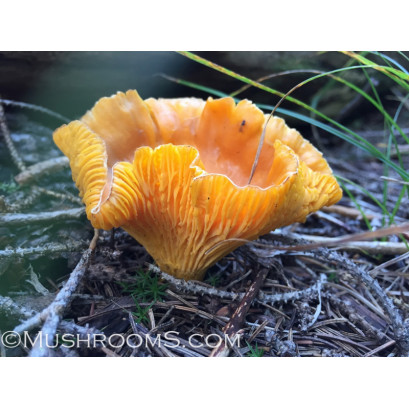Chanterelles (C.roseocanus ) mushrooms are one of the most delicious mushrooms a chef can work with. They have the sweet smell of apricots and a similar taste and a nice texture. Chanterelle’s go great with such wide varieties of foods but our personal favorite way to eat them is with a little apricot jelly and butter then topped over cheese crepes.
Chanterelles are a mycorrhizal fungi so they grow in nature by injecting their mycelia into the roots of plants and trees which forms a symbiotic relationship that benefits both the tree and the fungi. To my knowledge, chanterelles have never been grown indoors, although some researchers in Oregon had success in greenhouses by spawning the roots of young pine tree saplings. This species will need to be grown outdoors among trees. The best options for success is either to make a spore slurry and poor at the base roots of trees or saplings, or make spawn to bury under the soil near the roots of the host trees.
Chanterelles tend to produce a vast hidden underground network of mycelia. One of the most surprising things I have ever seen while mushroom hunting was finding some chanterelles in soil and rocks, and there was not a tree for at least 60 feet away. The soil did not even look like your typical rich, loose, humus forest soil and the area was not dense with trees, thus sunlight shining on the patch. I found the chanterelles growing in between a bunch rocks. I wish I had my camera with me that day but it has stuck in my head just how resilient the chanterelle mycelia network can be.
Common host trees that form symbiotic relationship with chanterelle fungi vary from region to region. If you know of more trees not listed here please email them to us and I’ll add them. In the Pacific NW they tend to grow around Douglas fir, tan oak and hemlock. In the northeast US white pines in summer but later in the season they grow around hemlock, balsam fir and oak. In the southeast chanterelles grow around maple, oak and poplar.
In the southwest US we find them in the mountain regions in the summer growing near ponderosa pine, spruce,Douglas fir,white fir,pinyon pine, and aspen.
Chanterelles are a cool weather mushroom, but not a cold weather mushroom. Temperatures are usually between 55F - 68F during summer rains for our southwest region. For spores to germinate 50F-60F would be ideal but surely the spawn run can be warmer or cooler.
If you know of other trees please let us know.
Good fast draining soil of low nitrogen and a low ph is important when selecting a a tree to cultivate chanterelles. Ideally the soil should be between 4 and 5.5 ph.
Chanterelle patches are usually guarded secrets by foragers but there is nothing stopping you from starting your own patches.This fungi will require some patience as it will take a year or two to see the first flush. As long as the tree is living and there is plenty of moisture, you should see continued flushes of delicious chanterelles year after year.
We do not know when this will be back in stock.
Chanterelles-C.roseocanus Spore PRINT
- Product Code: CHANT PRINT
- Availability:
-
$22.50
Tags: gourmet mushrooms, spore prints, mild weather mushrooms







